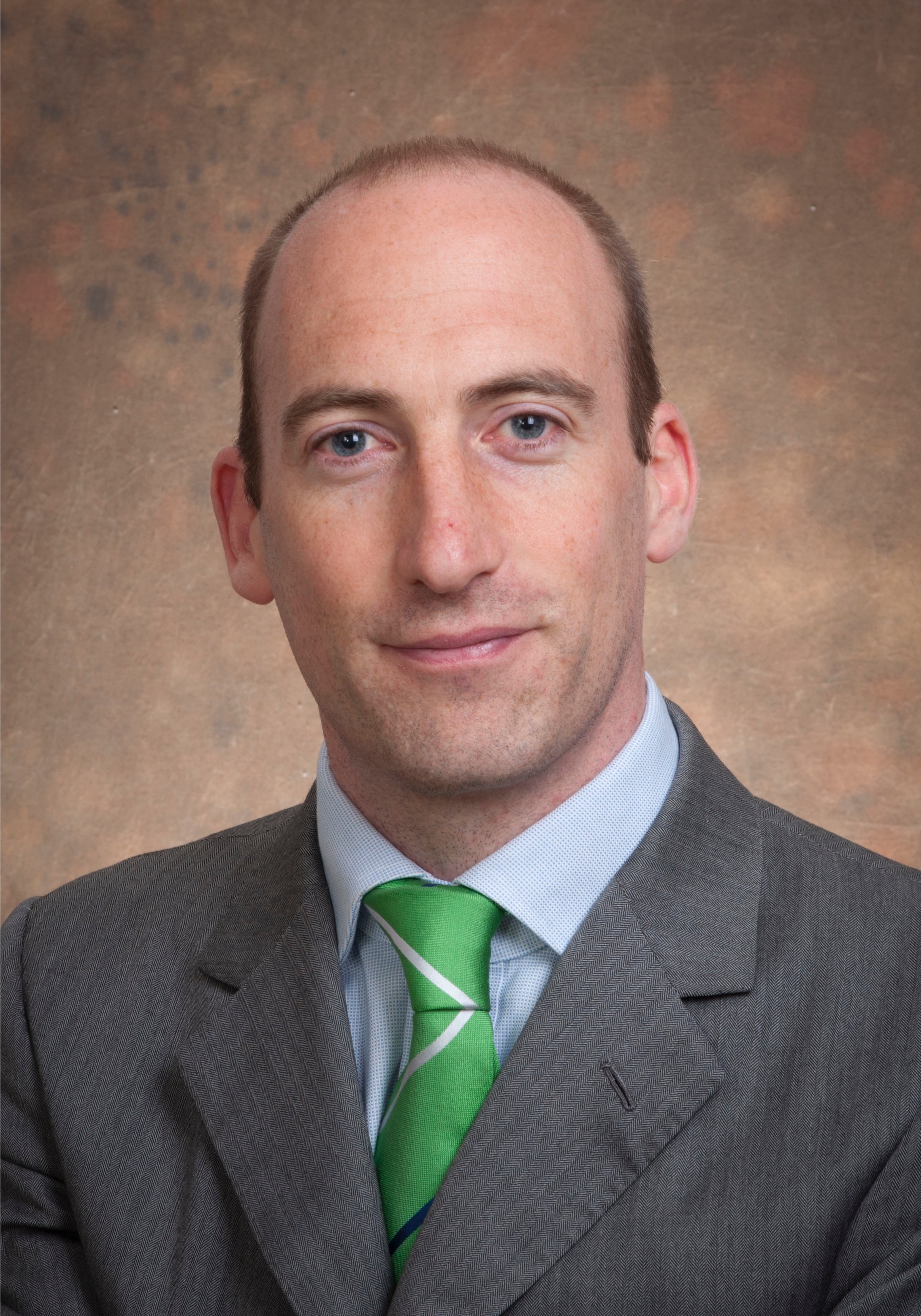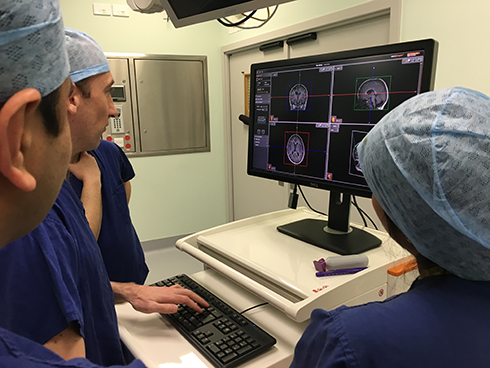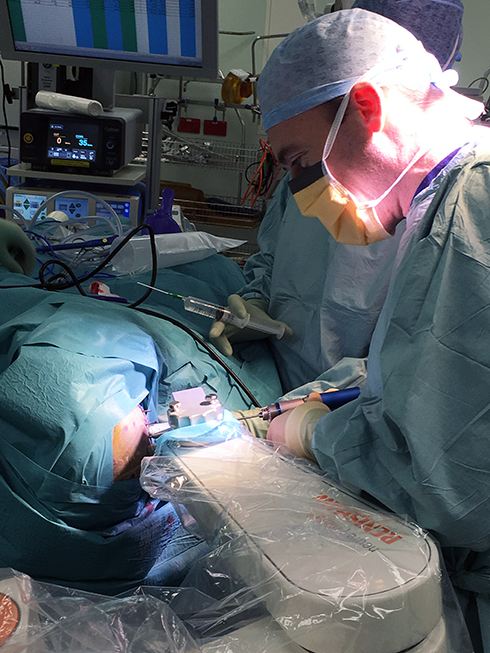Exploring the unexplored – reaching new depths with stereotactic neurosurgery
Read our interview with Mr Martin Tisdall, consultant paediatric neurosurgeon to find out how Renishaw is helping to revolutionise stereotactic neurosurgery.
Stereoelectroencephalography (SEEG) is a minimally invasive procedure used to identify the zone of epileptic seizure origin, and is of particular importance in patients with drug-resistant epilepsy. When it comes to identifying the epileptogenic zone in paediatric patients suffering from refractory epilepsy, accuracy is key. Inaccurate electrode placement can lead to aberrant signals or, at worst, intra- and post-operative bleeding, negatively impacting patient recovery time and placing additional stress on already-stretched healthcare resources.
Renishaw's solutions for stereotactic neurosurgery include a stereotactic robot, surgical planning software and depth electrodes, to help enhance patient safety and improve cost-effectiveness. With innovative technologies such as those offered by Renishaw, neurosurgeons can significantly improve patient outcomes through the safe and accurate delivery of electrodes.
We spoke to, Mr Martin Tisdall, consultant paediatric neurosurgeon at Great Ormond Street Hospital (GOSH), about how the neuromate® stereotactic robot and neuroinspire™ neurosurgical planning software from Renishaw have improved the diagnosis and treatment of refractory epilepsy in his patients.

Can you tell us a bit about yourself and your work?
"I'm a paediatric neurosurgeon, so I deal exclusively with children that have disorders of the brain. I finished my training in London in 2012 after spending a year at The Hospital for Sick Children [SickKids], Toronto, Canada, which is an internationally renowned paediatric neurosurgery centre."
"In 2013, I joined Great Ormond Street Hospital as a consultant and I now specialise in treating children with epilepsy. My particular interest is in identifying children who have epilepsy caused by a single area of abnormal electrical activity and finding ways to remove these areas or disrupt function."
"Epilepsy is a fairly common condition that affects about one per cent of the population. While most paediatric epilepsy cases are fairly well controlled with medication, about a quarter of children with epilepsy have seizures that are very poorly controlled, and when medications fail to work, quality of life is severely impacted. If were able to accurately detect the zone of seizure origin, we have between a 60% to 80% chance of curing their epilepsy - so in the right patient group this is a very successful treatment."
What led you to choose the neuromate stereotactic robot?
"Prior to the neuromate robot, we felt unhappy with the degree of precision when we were assessing individual patients, particularly with the high risk of hitting a blood vessel and causing collateral damage."
"We started using the neuromate robot and neuroinspire software in 2015. Typically, we use the robot in a technique called SEEG which helps us understand, very accurately, where seizures are arising from in the brain. neuromate allows us to implant very fine electrodes into different parts of the brain and record activity."
"We were keen to move to a more accurate system and evidence from the literature, along with positive feedback from other users, suggested that neuromate had the ability to do that. We certainly confirmed that in the data we subsequently collected."

"After using the neuromate for some time, we published a paper comparing the accuracy of the system we were using before, against the Renishaw system. On a case-by-case basis, we were able to compare the outcome of electrode implantation. We then put together the cohort of patients so that we could look at this on a group level and found that the neuromate robot offered far more certainty."
What are you using the Renishaw system for?
"We use the Renishaw system for stereotactic neurosurgery. Traditionally, we would record electrical activity from the scalp in patients as part of a pre-surgical evaluation. But in this more complex group where the epileptogenic zone is unclear, we place electrodes into the brain and record from them. Precisely positioning the electrodes allows us to avoid important structures, particularly blood vessels, so that we can record electrical activity in a safe manner."
"We also use the robot to implant electrodes for thermocoagulation. This treatment causes a small burn that disrupts the epileptic network and can be very successful. More recently, we've started using a technique called laser interstitial thermal therapy (LiTT) that requires very high levels of accuracy. In this case the Renishaw robot has been invaluable as we are often trying to target areas that are deep in the brain and have very important structures around them. The neuromate is the most accurate method we have."
"For patients where an abnormality may not be detected by MRI (magnetic resonance imaging), it can be quite difficult to understand where the epileptogenic zone might be. Or, in cases where it's hard to understand what's going on – such as where there are multiple potential areas, and we need to be much clearer on our decision making - SEEG using the neuromate is more reliable"
The neuromate has completely changed the way we operate. Its enabled us to take biopsies from various, highly sensitive areas of the brain, where a very high level of accuracy is needed to ensure confidence when performing procedures such as thermocoagulation, laser ablation, and deep brain stimulation.
What benefits have you seen as a result?
"The neuromate is invaluable and the benefits of using it are considerable! While neurosurgical navigation has been around since the 1970s, the neuromate automates the process in a way that limits the need for human interaction and thereby reduces the chance of human error. It also enables particular, more complex, trajectories which are not possible with the original frame-based systems. This has enabled us to safely access areas of the brain that were previously inaccessible without a high risk of damage to surrounding structures."
"Before 2015, we were using a different type of neuro navigation to do this. We were lucky enough to move to the Renishaw system, which provided a much more stable and accurate platform to speed up our workflow and this, in turn, has helped to increase efficiency and preserve hospital resources."
"When it comes to SEEG, one of the critical jobs of the robot is to register the patient and determine where the patients head is in space. The Renishaw system utilises a frame, which is the most accurate way of doing this registration and determination step compared to other available methods."
What's been your overall experience of Renishaw and it's neurosurgical solutions?
"There are three parts to the system, the neuromate robot, the DIXI depth electrodes and the neuroinspire software, which interacts with the neuromate. This enables us to plan the procedure by visualising and configuring trajectories to avoid important anatomical features, while correctly positioning electrodes. neuroinspire is incredibly invaluable because it can also be used as a standalone platform when using conventional arc systems."
"I've found the neuroinspire software to be very intuitive and easy-to-use. The DIXI electrodes are robust and reliable. More importantly, Renishaw offers a common point of contact for the entire system and it's been very useful for us to have that sense of security knowing that Renishaw offers an end-to-end solution."

Would you recommend Renishaw's neurosurgical solutions?
"Absolutely! Aside from great performance and reliability, the support from Renishaw is exceptional. They are always on-hand to provide advice or come down and help which is crucial if you have a technical problem in an operating theatre. When you have a child who's under general anaesthetic, an issue cant wait - not necessarily because it's dangerous - but because it's just not acceptable to wait hours for something to be fixed during a procedure. With Renishaw, thats never a problem, they offer a very high level of service and Ive found them to be very responsive and helpful."
Renishaw is applying precision engineering technology to the challenges of functional neurosurgery. Through the design, development and delivery of innovative neurosurgical solutions and systems, Renishaw's range of products is designed to enable surgeons to deliver devices with great confidence and accuracy. For further information on Renishaw's neurological products and systems, follow the links below.
Renishaw Neuro Solutions Limited – Legal and Privacy Notices. Click here